Since the funicular was closed on 25th August for “snagging” (see here) to address public safety concerns the re-opening date keeps getting put back. The latest is Monday – 16/10/2023!
Little further information has been forthcoming from HIE about the reasons for the closure or the work being done although following my post they did once again claim this was normal snagging practice:
 What a month ago was described as a major civil engineering project has now become a “complex engineering project”! The longer the funicular has been closed the more obvious it becomes that far more than snagging is involved. This post takes a further look at what has gone wrong.
What a month ago was described as a major civil engineering project has now become a “complex engineering project”! The longer the funicular has been closed the more obvious it becomes that far more than snagging is involved. This post takes a further look at what has gone wrong.
A specification unfit for purpose
I have been undertaking further research into the decision (see here) to build the funicular out of concrete rather than steel .
In 1995 Tim Whittome, the then Chief Executive of the Chairlift Company, wrote a letter to the Herald:
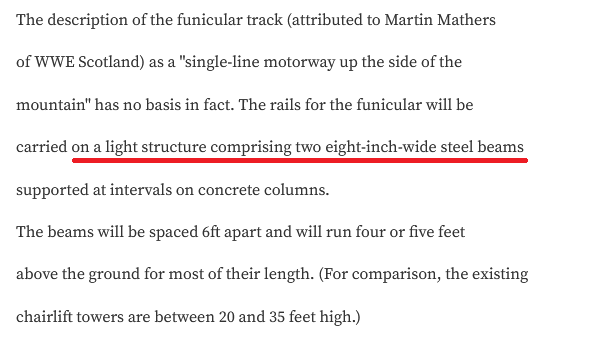
This letter shows that as late as November 1995 everyone was under the impression that the funicular would be built of concrete and light steel beams NOT just concrete.
This is further confirmed by the planning application that was lodged with the Highland Council (ref. 98/00254/FULBS) on 29/08/1994 which gave the go-ahead to the funicular on 27/03/1997. While I have submitted an FOI for a full copy of that planning application, the piers and foundations were to be made of concrete with steel “I” beams 8ins (20cms) wide. I have also established there are no further planning applications on the Highland Council website asking for permission to change the original plans.
Tim Whittome’s letter coupled with the planning application provides some answers to the three questions I posed in my first post on the decision to build the funicular with concrete beams (see here):
(1) Was the original design specification, used to obtain tenders from companies, for steel rather than concrete ?
(2) If so, when the specification was changed from steel to concrete were any other tenders sought?, and,
(3) Were A. F. Crudens paid first to design in steel and then again to change the specifications to concrete?
Q.1. The response to this is an emphatic YES.
Q 2. By implication this is probably a NO because Morrison Construction had already won the contract, and,
Q.3. Since there was no change to the planning application then A.F.Crudens were probably only paid to change the specifications for the “I” beams.
The important point here is that the foundations/ piers were left as they were BUT the changed concrete “I” beams on top of them were approximately 3.5 times heavier than the steel ones (see here). According to both an “I” beam manufacturer and a railway designer the span between the piers is too long for the weight of the concrete beams.
But increasing the number of foundations and piers to provide more support for the heavy concrete “I” beams or to enable shorter beams to be used would have needed a new planning application. This would have put the whole project in jeopardy because of the deadline for getting a grant from the European Union. It appears HIE decided to plough on despite the risks and have now reaped a £25m repair bill and rising.
HIE use of the term “snagging” to cover-up major problems
Having created a massive liability with the funicular HIE then tried to transfer the Cairngorms estate back to the Forestry Commission 2006/07. The FC were not fooled:
“In documents obtained by The Herald it was revealed that the Forestry Commission had serious concerns about the cost of bringing the ski area infrastructure “up to scratch”.
The F. C’s. senior official, Mr Hugh Insley, told colleagues
“There is a very real risk that in their (HIE’s) haste to tie this up they are trying to sweep some potentially big liabilities under the carpet. I am fairly clear that we should not do this deal without HIE retaining the long-term liabilities it has created at Cairngorm.” He went on, in an email in February 2007,
“Put simply there is a lot of poorly maintained infrastructure on a highly designated area. This must either be brought up to standard or removed”.
The month following the email, Mr Insley was advised to avoid “any involvement whatsoever with the ski area” by one of his negotiators”.
(Herald article 05/07/2008)
This provides a damning indictment of HIE’s management of the mountain and demonstrates a complete lack of trust in the negotiations with HIE! The article goes on to show this poorly maintained infrastructure included the funicular (just 6 years after it opened!).
“Among several “snagging issues” left over from the construction of the funicular railway in 2001 was the lack of lifting gear capable of removing the train from the tracks. According to one report, not being able to do this every five years was “severely impeding maintenance of rolling stock”.
Based on this record, the public should anticipate that the current snagging issues will continue for another six years! A response from HIE to Freedom of Information Requests revealed that the rolling stock had actually been removed for overhaul only once in the period 2001 – 2018.
The repairs to the concrete support beams and current “snagging” issues at Cairn Gorm
While it appears the specification for the size and number of foundations and piers was not changed after the decision to use concrete “I” beams, they will have been over specified (i.e significantly larger than required) for safety reasons. The original specification for the foundations and piers was therefore probably sufficient to support the weight of the new beams.

The bottom anchor block (photo above) – which is designed to stop the section of railway above moving downhill – and a few piers (photo below) have been reinforced but this is the exception, not the rule, and the explanation for why this was needed in these cases is unclear.

The real problem with more than tripling the weight of the beams was that their span meant they were too large to support their own weight given their intended use. It is for that reason that brackets have been added to strengthen the thinnest section of the beams on either side of each scarf joint as in the photo above.
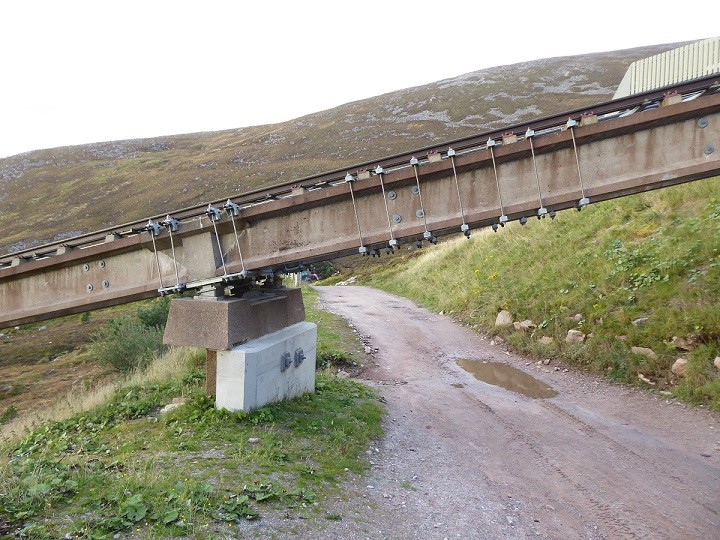
On many other beams, however, further brackets have been added to the strengthen the main section. This indicates the beams were at risk of breaking up.
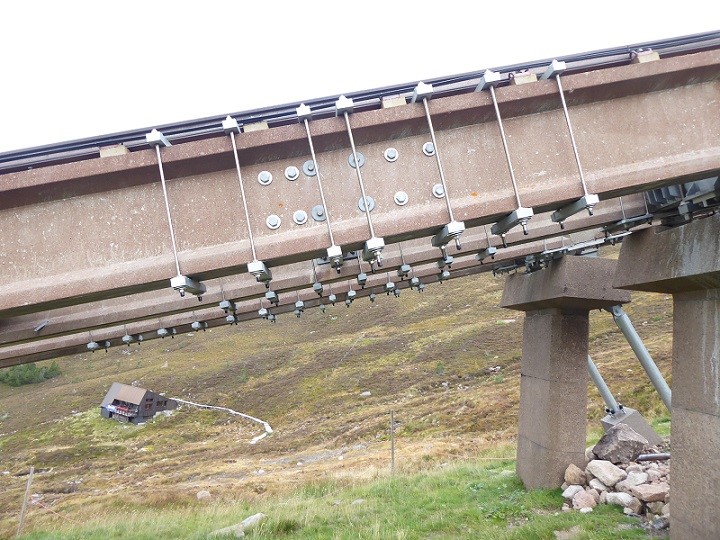
The numbers of brackets used to reinforce the concrete beams varies, as you can see from the photo above. This suggests that the risk of beams breaking up varied and when to use them was a finely judged exercise (easy to get wrong)
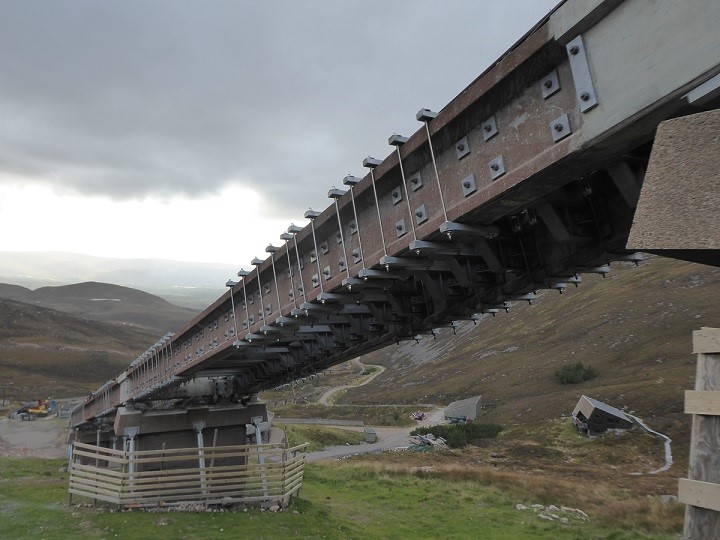
Some of the beams with brackets are at points which could have suffered higher stresses from the use of the railway:
- The beam below the exit from the tunnel at the top of the funicular;
- The beams immediately below the anchor blocks at Piers 78 and 65 (these are the only other reinforced beams between the tunnel and the mid-station);
- Around the mid-station;
- And on the curved sections below.
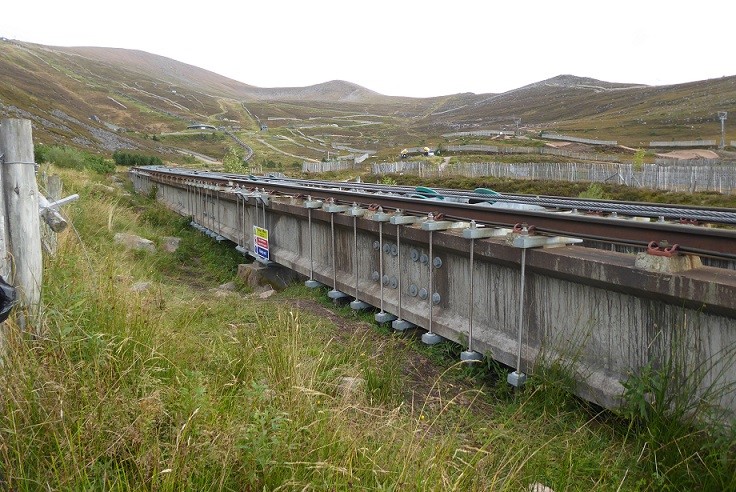
However, there are also brackets around beams on the lower section of straight horizontal track. This suggests that some of the beams may have been breaking up under their own weight.
What does all this tell us?
If the safety issue which HIE claims led to the funicular closure just lay in the tension of the brackets, that should have been sorted weeks ago. Measuring the tension and then adjusting nuts and bolts should not take that long but perhaps the funicular will re-open on Monday?
One possible explanation is that HIE has now found that further beams are cracking up, something which looks inevitable over the next few years because the spans are too big to support the weight. Or maybe new problems have emerged! What is certain is that HIE is not telling the whole story.
Postscript – update (from Nick Kempe)
A few hours after Graham’s post was published yesterday we saw the news release HIE issued yesterday (see here) stating the funicular would not now re-open until mid-November. During this week there appears to have been fairly intensive repair work being undertaken on the funicular and we had wrongly concluded this might be in an attempt to get the funicular open for Monday. Clearly the problems are far more serious than HIE is admitting.
The tension exerted on the beam by the steel rods will vary a fair bit due to temperature. Not ideal in a place that sees such large changes in weather. Whilst I hope this approach works I’m not filled with confidence. I also wonder whether those scarf joints were designed upside down, the joint seems to be in tension rather than compression!
I also wonder how many different types of concrete beam are in use. If there’s a chance of one failing it seems prudent to have spares on hand to minimise downtime. Clearly this is no small task if many different designs have been used.
(1) The COWI report of Dec 2018. Min effective bridge temp of -19C with a max of +29C. (2) If the beams had been designed with the scarf joints the opposite way up then there would have been a smaller chance of corners breaking off? (3) There are three typres of “I” beam, (a) straight, (b) with a curve radius of 200m and (c) a curve radius of 300m.. Spares!!!
What’s happening is that HIE are continuing to preside over a Pantomime. The latest announcement, made today, that the Funicular will remain closed into November is now the 7th time that the present closure has been extended. That clearly suggests that these engineering works are much more than the ‘snagging works’ that HIE claim. HIE also say that the works are being paid for by the contractor and so are costless. That is fundamentally untrue since the loss of business revenue will lead directly to an increase in the public subsidy provided. Furthermore, this closure, which will certainly exceed over 2 months has made it abundantly clear that the Funicular and the CairnGorm ‘resort’ isn’t the key driver of the local tourist economy as HIE claim. Hard questions now need to be asked about the continuation of an annual public subsidy into the future. Is it the job of government to prop up an incompetently managed business with free public handouts?
“HIE also say…….costless”. I fail to understand why a contractor, and I presume it is Balfour Beatty that is being referred to, would pay for the works if the work they were contracted to do was completed to allow the DfT to issue its certification. Are HIE saying the work was not finished before the funicular re-opened? If that’s so then why did it take until 25/08/2023, and closure of the funicular on public safety grounds, for work to recommence? Will the work need recertifying before the funicular can re-open? So many questions going unanswered.
Good work by yourselves. I hope the fiasco reaches its endgame soon.
I’m not a structural engineer but certainly wooden scarf joints are usually the other way up…
Maybe explains the extra plates and bolts in your second pic. The I-Beams are all upside down, surely not!
Well done, Graham, in digging up all these important questions about the structural failure of the funicular. As history shows on numerous unrelated errors of judgment by public bodies, it’s not the original mistake that is the problem – it’s the cover up which can go on for years at great public expense until the cover up blows up in their faces.
HIE have been in cover up mode on the funicular mistakes for 20 years now. It looks like the cover up is close to blowing up in their faces. Many, including, various politicians, have been asking for a public enquiry into all these issues. The time is now way overdue for the Scottish Government to face up to yet another disaster with public funds and pull the rug from under HIE.
The problem is that the HIE Board is in this so deep that they will keep on spending public money to cover up for their incompetence. It is very probable that parts of the Scottish Government have been and continue to be knowingly involved in the cover up and HIE will be reminding them of their involvement.